
Create A Daily Routine For Organizing Paperwork {To Keep Paper Clutter At Bay}
Paper comes into your house daily, so here's how to create a daily routine for organizing paperwork to deal with it, so you can keep paper clutter at bay, and instead feel in control of the paper monster.
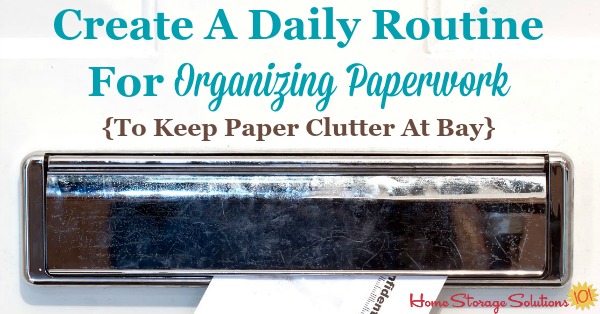
When I talk about a daily routine, I'm not talking about a huge time investment, but instead generally 3-5 minutes of your time each day.
But the key is consistency. Every day that you receive mail or other paper finds its way into your home, be that in your child's backpack, papers from work or church, or wherever else, you need to deal with it.
"Dealing with" the paperwork also does not necessarily involve taking every step necessary to complete every action that piece of paper might require you to take, such as paying the bill, filing the bank statement, or filling out the permission slip. Instead, dealing with it involves examining every piece of mail and incoming paper daily, as part of your routine, and making a decision of where it will go in your home mail organizer center that you're creating as part of the Organize Mail Challenge here on the site.
Four Choices For Each Piece Of Mail Or Paper That Comes Into Your Home
For each piece of mail or paper that comes into your home daily you have four possible choices for it, and when you make one of these choices for the mail or paper that comes into your home each day you will not get a lot of paper clutter accumulating in the future.
Here are your choices:
Choice 1: Trash, Recycle Or Shred It
This is one of my favorites choices -- trash, recycle, or shred it, and you should use this choice liberally. Don't keep things you don't need. If something is trash, treat it as such and don't keep it in your house a second longer than necessary.
As you get this junk out of your home though make sure you're doing it safely, to protect your sensitive personal information. Here's the ultimate guide to what documents to shred or otherwise destroy, as opposed to placing directly into the trash or recycle bin.
Many people know that a lot of stuff they receive from their kids schools, or in the mail each day, is pure junk. They have gone so far as to put a small recycling bin and a shredder somewhere near the area they do this daily routine for organizing paperwork, and shredding as they go, or trashing immediately. It makes the process really easy.
If you want to shred daily, as you come across known junk, make sure to choose a good paper shredder for your home. Here's my article with the criteria you should consider when choosing your home paper shredder.
If you don't want to shred daily though you will need to designate an area to place your shredding piles until you're ready to destroy them. The linked article provides ideas for this area, plus tips for keeping up with your shredding pile so it doesn't get too overwhelming.
Choice 2: Pass It On To Someone Else To Deal With It (Delegate)
You will inevitably run across mail items that aren't yours, or that should be dealt with by someone else in the family, or someone you've hired to assist you in various areas of your life, such as a lawyer, accountant, etc.
For each of these items, if you can delegate it right then, within two minutes, do so. If not, put a sticky note on it with the next action step to be taken (delegate to ________), and stick it in an inbox, basket, or file you've designated for paperwork you'll deal with during your weekly paperwork time (see the next article in the series, about the weekly session for organizing paper for more information about this weekly appointment with yourself).
Choice 3: Information Not Needed Now, But Should Be Kept For The Future (File It)
If you get something you don't need right now, but will need to reference in the future, place it in the right file right then and there, if possible.
If you can be disciplined enough to file weekly, at the end of your weekly paperwork session in your home, you can place these types of things in a "to be filed" file instead.
(You can learn more about organizing your filing system in your home here.)
Choice 4: You Need To Take Action With It
Many pieces of mail, and other influxes of paper that you receive on a daily basis fall into the category of items you need to take action upon.
These can be further categorized into papers you need to take action on relatively quickly versus a while from now.
The further out you need to take an action on something, the easier it is to misplace the paper in the mean time. These are the perfect types of items you should place in a tickler file. (If you don't know what this is click the link for an article explaining the concept, how to make it, and picture examples.)
Other items you need to take action on more quickly include things like bills, invitations, insurance and medical information, paperwork you need to read and study before it is filed, things you need to put on your calendar, etc.
Here is where you really need to implement the two minute rule. The two minute rule requires that you should not put off anything that takes you less than two minutes to do, right then.
The reasoning behind this rule is that if you put it down after you've picked it up and determined what you need to do with it, you'll just have to re-remember in your mind what it was again alter, perhaps by re-reading the paper all over again in the future. That will waste at least two minutes of your time, so once you pick it up you've got to do it right them, if it takes less than two minutes to do it.
Examples of things you could do in two minutes including signing the permission slip or putting a date of an event on your calendar.
However, no one expects you to pay every bill as soon as it comes in, or make a phone call the second you read something requiring that action from you. You save more time by batching most tasks.
Therefore, when you sort your mail you place all of the things that you need to do, but that would take you more than two minutes, into your inbox, basket or tickler file, which is part of your home mail organizer center, to deal with later, during your weekly appointment for dealing with paperwork.
If your next action is obvious upon first sight, such as pay the bill, you don't necessarily need to write yourself a note about what to do with that piece of paper before placing it in the inbox.
However, if you realize your next step is something more complicated, grab yourself a sticky note and write down what you've got to do next, so it is easier for you to accomplish your tasks during your weekly paperwork time without completely having to re-read or redo your thinking process again in the future.
Create A Place To Hold Your Paperwork Based On The Decisions Made
As you noticed for the four choices for each piece of paper or mail that come into your home above, I mentioned putting items in a tickler file, or an inbox, or a shredding pile, or a place for later action with your weekly paperwork session.
To make your daily routine for organizing paperwork easy to stick with you need to have these places designated somewhere in your home, like in your home office, or in a section of your kitchen where you do paperwork, or wherever works for you in your home. That way each day you don't have to create new piles for these things, but instead you have a designated space for them.
Here's a couple of examples from readers who've made these types of areas in their home to give you some examples, so you can create such a space for yourself. The first example is on the right, and is from a reader, Tamara. She explained, "I shred once a week because I don't have room for more than that. Much of the mail goes directly into my SHRED bin to be handled on the weekend. I don't scan yet. I have no confidence in digital because of my neglect of consistent backups" but she added, she's working on it!
Another example came from a reader, Camisha, who showed the plastic drawers she's designated for this daily sorting process. She said, "Junk goes in recycle can immediately, but I get really caught up on the 'needs attention' stuff. Some I just have to verify, others need to call on, make adjustments, or watch for payments to come through (Ie. insurance). Then my 'urgent' file I deal with more frequently, due to it's nature."
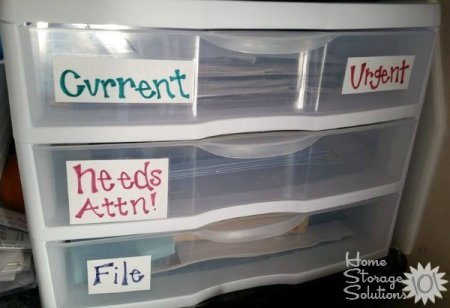
Want To Do More Decluttering Missions? Get Started With Declutter 365 Today!
Once you declutter one type of item in your home I bet you'll want to declutter some more. After all, decluttering gives you a great reward for even a small investment of time and energy.
The Declutter 365 system is designed to help you declutter, over the course of a year, your entire house, with just 15 minutes of decluttering each day!
Hundreds of thousands of people use this proven system to get rid of their clutter, and bring peace and calm back to their homes.
Declutter 365 works to guide you to clear the clutter without overwhelm, focusing on just one small area at a time, and without making a huge mess in the process, so you see consistent forward progress without all that "messy middle" that makes it even harder to function in your home than before you started.
In addition to building a daily decluttering habit, the Declutter 365 program, along with the accompanying 52 Week Organized Home Challenge, teaches you the skills, habits, routines, and mindsets necessary to maintain the clutter free and organized state of your home from now on, so it'll never be as messy and cluttered as it is right now, ever again.
If you haven't already, make sure to get your copy of this year's Declutter 365 annual calendar here (it's FREE!), find today's date, and do 15 minutes of decluttering on the day's mission. Then, repeat again tomorrow, and again and again. Over the course of the next year, if you do this 15 minutes per day, you'll declutter your whole house!

Get This Paper & Filing Decluttering Checklist + 32 Other Decluttering Checklists For Your Home
Right now you're decluttering your papers and files, and there's a lot of types and varieties of these around your home.
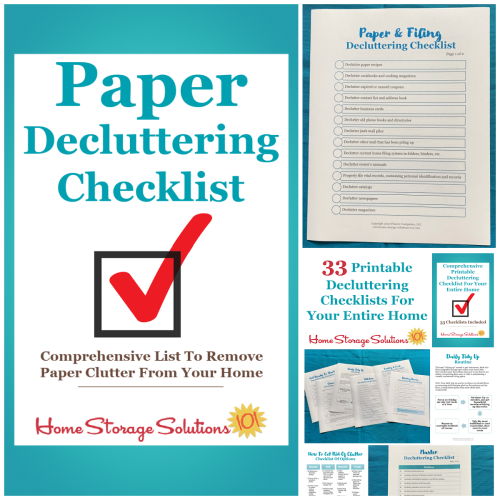
I've done the hard work of breaking down these tasks into smaller more manageable steps for you, so you don't get overwhelmed or worry you're forgetting a task, and you can go at the pace you want, whether that's fast or slow.
In addition, you can tackle these decluttering tasks in whatever order you want when you use these checklists!

What's Next In The Paper Organization Series?
This article began the section of the Paper Organization Series that is focused on building our systems and routines to keep paper from accumulating so much again in the future in our homes and feeling so overwhelming.
Hint: You can use this same system of four choices daily as you check your email inbox, to keep it organized and free from email clutter. Check out my article about organizing your email account using folders here, for more details.
Once you've got your daily routine for paper under control you need to combine it with a weekly paperwork session to completely deal with the paperwork that comes into your home, and doing the tasks necessary in regard to it. You can read all about how and why to create a weekly paperwork session for organizing paper here.
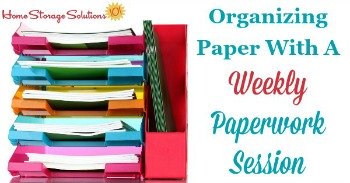
Did You Know That Doing This Daily Paperwork Session Is Part Of Your Daily Tidy Up Routine?
Keeping all kinds of loose paper from accumulating in your home, on flat surfaces, and elsewhere keeps your home tidy and clutter free, and therefore doing this step every day is part of the daily tidy up routine for your home.
You can find out more about this routine here:

Some links on this page are affiliate links, meaning that if you purchase a product through them I receive a small commission which helps me provide this information to you for free, plus support my family. My integrity and your satisfaction are very important to me so I only recommend products I would purchase myself, and that I believe would benefit you. To learn more please see my disclosure statement.
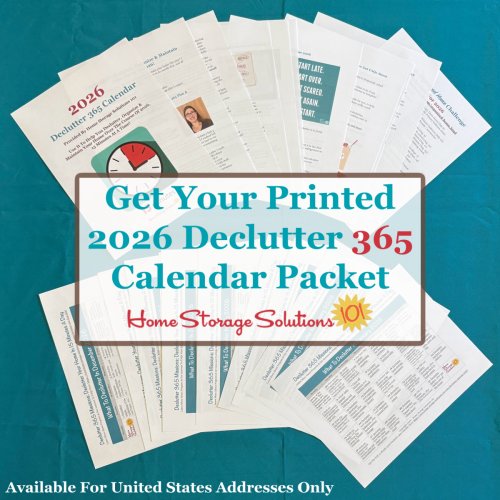
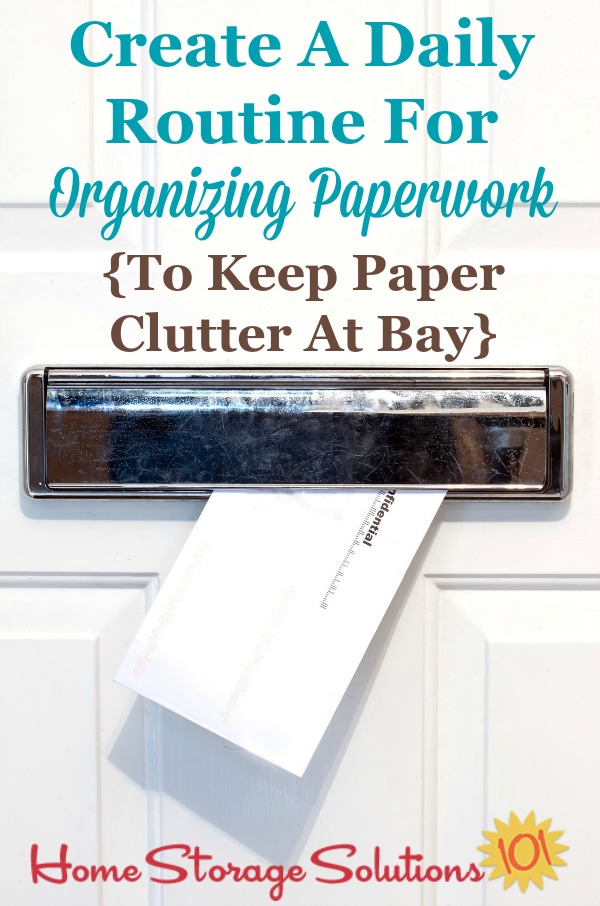

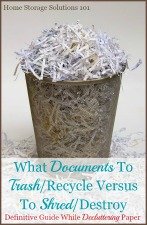
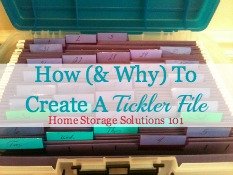
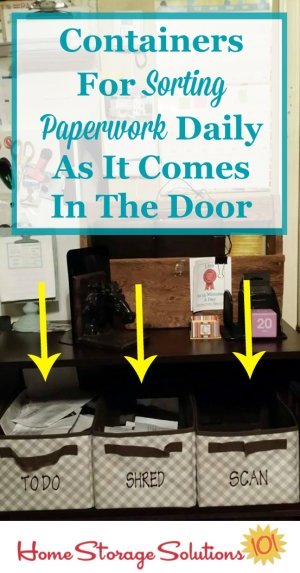
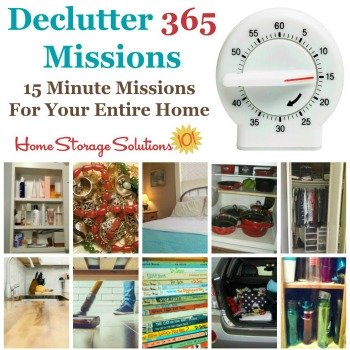

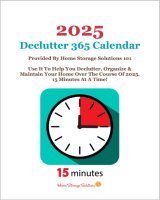
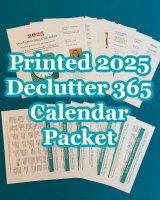
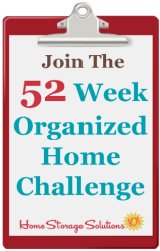



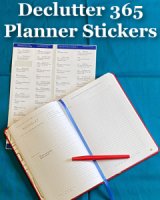

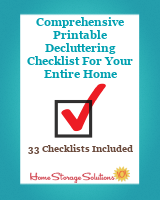





Share Your Comments, Tips & Ideas
I would love to hear from you, sharing your thoughts, questions, or ideas about this topic, so leave me a comment below. I try to always respond back!